|
|
| |
|
|
| |
|
|
|
|
| |
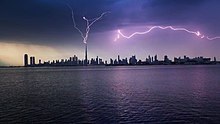 |
| Lightning striking
the world's tallest building — Burj Khalifa. |
Lightning
Lightning is a naturally occurring electrostatic
discharge during which two electrically charged regions
in the atmosphere or ground temporarily equalize
themselves, causing the instantaneous release of as much
as one gigajoule of energy. This discharge may produce a
wide range of electromagnetic radiation, from very hot
plasma created by the rapid movement of electrons to
brilliant flashes of visible light in the form of
black-body radiation. Lightning causes thunder, a sound
from the shock wave which develops as gases in the
vicinity of the discharge experience a sudden increase
in pressure. Lightning occurs commonly during
thunderstorms and other types of energetic weather
systems, but volcanic lightning can also occur during
volcanic eruptions.
The three main kinds of lightning are distinguished by
where they occur: either inside a single thundercloud,
between two different clouds, or between a cloud and the
ground. Many other observational variants are
recognized, including "heat lightning", which can be
seen from a great distance but not heard; dry lightning,
which can cause forest fires; and ball lightning, which
is rarely observed scientifically.
Humans have deified lightning for millennia. Idiomatic
expressions derived from lightning, such as the English
expression "bolt from the blue", are common across
languages. |
|
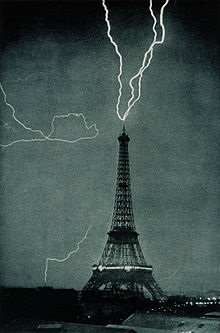 |
| Lightning striking
the Eiffel Tower on the 3rd of June, 1902, at
21:20. This is one of the earliest photographs
of lightning in an urban setting. |
Discovery of Lightning
Benjamin Franklin was interested in lightning. He
discovered many things about it, and in 1772, he was the
first to show that a thunderstorm lets out electricity.
In his book he suggested an experiment to test it.
Franklin did not really go out in a thunder storm and
fly a kite in an attempt to prove the presence of
electricity in the storm. If that had happened Franklin
may have been killed, though it is possible to conduct
electricity through the kite, and down the string.
Electrification
The details of the charging process are still being
studied by scientists, but there is general agreement on
some of the basic concepts of thunderstorm
electrification. The main charging area in a
thunderstorm occurs in the central part of the storm
where air is moving upward rapidly (updraft) and
temperatures range from −15 to −25 Celsius, see figure
to the right. At that place, the combination of
temperature and rapid upward air movement produces a
mixture of super-cooled cloud droplets (small water
droplets below freezing), small ice crystals, and
graupel (soft hail). The updraft carries the
super-cooled cloud droplets and very small ice crystals
upward. At the same time, the graupel, which is
considerably larger and denser, tends to fall or be
suspended in the rising air.
The differences in the movement of the precipitation
cause collisions to occur. When the rising ice crystals
collide with graupel, the ice crystals become positively
charged and the graupel becomes negatively charged. See
figure to the left. The updraft carries the positively
charged ice crystals upward toward the top of the storm
cloud. The larger and denser graupel is either suspended
in the middle of the thunderstorm cloud or falls toward
the lower part of the storm.
The result is that the upper part of the thunderstorm
cloud becomes positively charged while the middle to
lower part of the thunderstorm cloud becomes negatively
charged.
The upward motions within the storm and winds at higher
levels in the atmosphere tend to cause the small ice
crystals (and positive charge) in the upper part of the
thunderstorm cloud to spread out horizontally some
distance from thunderstorm cloud base. This part of the
thunderstorm cloud is called the anvil. While this is
the main charging process for the thunderstorm cloud,
some of these charges can be redistributed by air
movements within the storm (updrafts and downdrafts). In
addition, there is a small but important positive charge
buildup near the bottom of the thunderstorm cloud due to
the precipitation and warmer temperatures.
Types
There are three primary types of lightning, defined by
what is at the "ends" of a flash channel. |
- Intracloud (IC), which occurs within
a single thundercloud unit
- Cloud to cloud (CC) or intercloud,
which starts and ends between two different "functional"
thundercloud units
- Cloud to ground (CG), that primarily
originates in the thundercloud and terminates on an
Earth surface, but may also occur in the reverse
direction, that is ground to cloud
There are variations of each type, such as "positive"
versus "negative" CG flashes, that have different
physical characteristics common to each which can be
measured. Different common names used to describe a
particular lightning event may be attributed to the same
or different events.
|
|
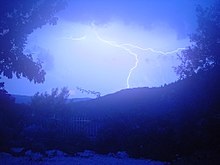 |
| Cloud-to-ground
lightning. |
Cloud to ground (CG)
Cloud-to-ground (CG) lightning is a lightning discharge
between a thundercloud and the ground. It is initiated by a
stepped leader moving down from the cloud, which is met by a
streamer moving up from the ground.
CG is the least common, but best understood of all types of
lightning. It is easier to study scientifically, because it
terminates on a physical object, namely the Earth, and lends
itself to being measured by instruments on the ground. Of
the three primary types of lightning, it poses the greatest
threat to life and property since it terminates or "strikes"
the Earth. The overall discharge, termed a flash, is
composed of a number of processes such as preliminary
breakdown, stepped leaders, connecting leaders, return
strokes, dart leaders and subsequent return strokes.
Positive and negative lightning
Cloud-to-ground (CG) lightning is either positive or
negative, as defined by the direction of the conventional
electric current from cloud to ground. Most CG lightning is
negative, meaning that a negative charge is transferred to
ground and electrons travel downward along the lightning
channel. The reverse happens in a positive CG flash, where
electrons travel upward along the lightning channel and a
positive charge is transferred to the ground. Positive
lightning is less common than negative lightning, and on
average makes up less than 5% of all lightning strikes.
There are six different mechanisms theorized to result in
the formation of downward positive lightning. |
- Vertical wind shear displacing the
upper positive charge region of a thundercloud, exposing
it to the ground below.
- The loss of lower charge regions in
the dissipating stage of a thunderstorm, leaving the
primary positive charge region.
- A complex arrangement of charge
regions in a thundercloud, effectively resulting in an
inverted dipole or inverted tripole in which the main
negative charge region is above the main positive charge
region instead of beneath it.
- An unusually large lower positive
charge region in the thundercloud.
- Cutoff of an extended negative
leader from its origin which creates a new bidirectional
leader in which the positive end strikes the ground,
commonly seen in anvil-crawler spider flashes.
- The initiation of a downward
positive branch from an intracloud lightning flash.
|
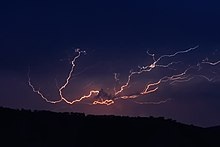 |
| Multiple paths of
cloud-to-cloud lightning, Swifts Creek,
Australia. |
Contrary to popular belief, positive lightning flashes do
not necessarily originate from the anvil or the upper
positive charge region and strike a rain-free area outside
of the thunderstorm. This belief is based on the outdated
idea that lightning leaders are unipolar in nature and
originating from their respective charge region.
Positive lightning strikes tend to be much more intense than
their negative counterparts. An average bolt of negative
lightning carries an electric current of 30,000 amperes (30
kA), and transfers 15 coulombs of electric charge and 500
megajoules of energy. Large bolts of negative lightning can
carry up to 120 kA and 350 coulombs. The average positive
ground flash has roughly double the peak current of a
typical negative flash, and can produce peak currents up to
400,000 amperes (400 kA) and charges of several hundred
coulombs. Furthermore, positive ground flashes with high
peak currents are commonly followed by long continuing
currents, a correlation not seen in negative ground flashes.
As a result of their greater power, as well as lack of
warning, positive lightning strikes are considerably more
dangerous. Due to the aforementioned tendency for positive
ground flashes to produce both high peak currents and long
continuing current, they are capable of heating surfaces to
much higher levels which increases the likelihood of a fire
being ignited.
Positive lightning has also been shown to trigger the
occurrence of upward lightning flashes from the tops of tall
structures and is largely responsible for the initiation of
sprites several tens of kilometers above ground level.
Positive lightning tends to occur more frequently in winter
storms, as with thundersnow, during intense tornadoes and in
the dissipation stage of a thunderstorm. Huge quantities of
extremely low frequency (ELF) and very low frequency (VLF)
radio waves are also generated.
A unique form of cloud-to-ground lightning exists where
lightning appears to exit from the cumulonimbus cloud and
propagate a considerable distance through clear air before
veering towards, and striking, the ground. For this reason,
they are known as "bolts from the blue". Despite the popular
misconception that these are positive lightning strikes due
to them seemingly originating from the positive charge
region, observations have shown that these are in fact
negative flashes. They begin as intracloud flashes within
the cloud, the negative leader then exits the cloud from the
positive charge region before propagating through clear air
and striking the ground some distance away. |
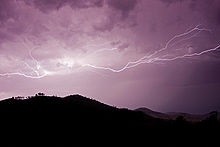 |
| Cloud-to-cloud
lightning, Victoria, Australia. |
Cloud to cloud (CC) and
intra-cloud (IC)
Lightning discharges may occur between areas of cloud
without contacting the ground. When it occurs between two
separate clouds it is known as inter-cloud lightning, and
when it occurs between areas of differing electric potential
within a single cloud it is known as intra-cloud lightning.
Intra-cloud lightning is the most frequently occurring type.
Intra-cloud lightning most commonly occurs between the upper
anvil portion and lower reaches of a given thunderstorm.
This lightning can sometimes be observed at great distances
at night as so-called "sheet lightning". In such instances,
the observer may see only a flash of light without hearing
any thunder.
Another term used for cloud–cloud or cloud–cloud–ground
lightning is "Anvil Crawler", due to the habit of charge,
typically originating beneath or within the anvil and
scrambling through the upper cloud layers of a thunderstorm,
often generating dramatic multiple branch strokes. These are
usually seen as a thunderstorm passes over the observer or
begins to decay. The most vivid crawler behavior occurs in
well developed thunderstorms that feature extensive rear
anvil shearing.
Observational variations |
- Anvil crawler lightning, sometimes
called Spider lightning is created when leaders
propagate through horizontally-extensive charge regions
in mature thunderstorms, usually the stratiform regions
of mesoscale convective systems. These discharges
usually begin as intracloud discharges originating
within the convective region; the negative leader end
then propagates well into the aforementioned charge
regions in the stratiform area. If the leader becomes
too long, it may separate into multiple bidirectional
leaders. When this happens, the positive end of the
separated leader may strike the ground as a positive CG
flash or crawl on the underside of the cloud, creating a
spectacular display of lightning crawling across the
sky. Ground flashes produced in this manner tend to
transfer high amounts of charge, and this can trigger
upward lightning flashes and upper-atmospheric
lightning.
- Ball lightning may be an atmospheric
electrical phenomenon, the physical nature of which is
still controversial. The term refers to reports of
luminous, usually spherical objects which vary from
pea-sized to several meters in diameter. It is sometimes
associated with thunderstorms, but unlike lightning
flashes, which last only a fraction of a second, ball
lightning reportedly lasts many seconds. Ball lightning
has been described by eyewitnesses but rarely recorded
by meteorologists. Scientific data on natural ball
lightning is scarce owing to its infrequency and
unpredictability. The presumption of its existence is
based on reported public sightings, and has therefore
produced somewhat inconsistent findings. Brett Porter,
wildlife ranger, reported having taken a photo at
Queensland of Australia in 1987.
- Bead lightning is the decaying stage
of a lightning channel in which the luminosity of the
channel breaks up into segments. Nearly every lightning
discharge will exhibit beading as the channel cools
immediately after a return stroke, sometimes referred to
as the lightning's 'bead-out' stage. 'Bead lightning' is
more properly a stage of a normal lightning discharge
rather than a type of lightning in itself. Beading of a
lightning channel is usually a small-scale feature, and
therefore is often only apparent when the
observer/camera is close to the lightning.
- Cloud-to-air lightning is a
lightning flash in which one end of a bidirectional
leader exits the cloud, but does not result in a ground
flash. Such flashes can sometimes be thought of as
failed ground flashes. Blue jets and gigantic jets are a
form of cloud-to-air or cloud-to-ionosphere lightning
where a leader is launched from the top of a
thunderstorm.
- Dry lightning is used in Australia,
Canada and the United States for lightning that occurs
with no precipitation at the surface. This type of
lightning is the most common natural cause of wildfires.
Pyrocumulus clouds produce lightning for the same reason
that it is produced by cumulonimbus clouds.
- Forked lightning is cloud-to-ground
lightning that exhibits branching of its path.
- Heat lightning is a lightning flash
that appears to produce no discernible thunder because
it occurs too far away for the thunder to be heard. The
sound waves dissipate before they reach the observer.
- Ribbon lightning occurs in
thunderstorms with high cross winds and multiple return
strokes. The wind will blow each successive return
stroke slightly to one side of the previous return
stroke, causing a ribbon effect.
- Rocket lightning is a form of cloud
discharge, generally horizontal and at cloud base, with
a luminous channel appearing to advance through the air
with visually resolvable speed, often intermittently.
- Sheet lightning is cloud-to-cloud
lightning that exhibits a diffuse brightening of the
surface of a cloud, caused by the actual discharge path
being hidden or too far away. The lightning itself
cannot be seen by the spectator, so it appears as only a
flash, or a sheet of light. The lightning may be too far
away to discern individual flashes.
- Smooth channel lightning is an
informal term referring to a type of cloud-to-ground
lightning strike that has no visible branching and
appears like a line with smooth curves as opposed to the
jagged appearance of most lightning channels. They are a
form of positive lightning generally observed in or near
the convective regions of severe thunderstorms in the
north central United States. It is theorized that severe
thunderstorms in this region obtain an "inverted tripole"
charge structure in which the main positive charge
region is located below the main negative charge region
instead of above it, and as a result these thunderstorms
generate predominantly positive cloud-to-ground
lightning. The term "smooth channel lightning" is also
sometimes attributed to upward ground-to-cloud lightning
flashes, which are generally negative flashes initiated
by upward positive leaders from tall structures.
- Staccato lightning is a
cloud-to-ground lightning (CG) strike which is a
short-duration stroke that (often but not always)
appears as a single very bright flash and often has
considerable branching. These are often found in the
visual vault area near the mesocyclone of rotating
thunderstorms and coincides with intensification of
thunderstorm updrafts. A similar cloud-to-cloud strike
consisting of a brief flash over a small area, appearing
like a blip, also occurs in a similar area of rotating
updrafts.
- Superbolts are bolts of lightning
around a hundred times brighter than normal. On Earth,
one in a million lightning strikes is a superbolt.
- Sympathetic lightning is the
tendency of lightning to be loosely coordinated across
long distances. Discharges can appear in clusters when
viewed from space.
- Upward lightning or ground-to-cloud
lightning is a lightning flash which originates from the
top of a grounded object and propagates upward from this
point. This type of lightning can be triggered by a
preceding lightning flash, or it may initiate entirely
on its own. The former is generally found in regions
where spider lightning occurs, and may involve multiple
grounded objects simultaneously. The latter usually
occurs during the cold season and may be the dominant
lightning type in thundersnow events.
- Clear-air lightning describes
lightning that occurs with no apparent cloud close
enough to have produced it. In the U.S. and Canadian
Rockies, a thunderstorm can be in an adjacent valley and
not observable from the valley where the lightning bolt
strikes, either visually or audibly. European and Asian
mountainous areas experience similar events. Also in
areas such as sounds, large lakes or open plains, when
the storm cell is on the near horizon (within 26 km (16
mi)) there may be some distant activity, a strike can
occur and as the storm is so far away, the strike is
referred to as a bolt from the blue. These flashes
usually begin as normal intracloud lightning flashes
before the negative leader exits the cloud and strikes
the ground a considerable distance away. Positive
clear-air strikes can occur in highly sheared
environments where the upper positive charge region
becomes horizontally displaced from the precipitation
area.
|
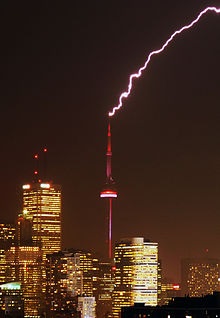 |
| Certain prominent
structures often attract frequent lightning
strikes. The CN Tower in Toronto is struck many
times every summer. |
Effects
Lightning strike
Objects struck by lightning experience heat and magnetic
forces of great magnitude. The heat created by lightning
currents traveling through a tree may vaporize its sap,
causing a steam explosion that bursts the trunk. As
lightning travels through sandy soil, the soil surrounding
the plasma channel may melt, forming tubular structures
called fulgurites. Even though roughly 90 percent of people
struck by lightning survive, humans or animals struck by
lightning may suffer severe injury due to internal organ and
nervous system damage. Buildings or tall structures hit by
lightning may be damaged as the lightning seeks unintended
paths to ground. By safely conducting a lightning strike to
ground, a lightning protection system can greatly reduce the
probability of severe property damage. Lightning also serves
an important role in the nitrogen cycle by oxidizing
diatomic nitrogen in the air into nitrates which are
deposited by rain and can fertilize the growth of plants and
other organisms.
Thunder
Because the electrostatic discharge of terrestrial lightning
superheats the air to plasma temperatures along the length
of the discharge channel in a short duration, kinetic theory
dictates gaseous molecules undergo a rapid increase in
pressure and thus expand outward from the lightning creating
a shock wave audible as thunder. Since the sound waves
propagate not from a single point source but along the
length of the lightning's path, the sound origin's varying
distances from the observer can generate a rolling or
rumbling effect. Perception of the sonic characteristics is
further complicated by factors such as the irregular and
possibly branching geometry of the lightning channel, by
acoustic echoing from terrain, and by the typically
multiple-stroke characteristic of the lightning strike.
Light travels at about 300,000,000 m/s, and sound travels
through air at about 343 m/s. An observer can approximate
the distance to the strike by timing the interval between
the visible lightning and the audible thunder it generates.
A lightning flash preceding its thunder by one second would
be approximately 343 m (0.213 mi) in distance; a delay of
three seconds would indicate a distance of about one
kilometer (0.62 mi) (3×343 m). A flash preceding thunder by
five seconds would indicate a distance of approximately one
mile (1.6 km) (5×343 m). Consequently, a lightning strike
observed at a very close distance will be accompanied by a
sudden clap of thunder, with almost no perceptible time
lapse, possibly accompanied by the smell of ozone (O3).
Lightning at a sufficient distance may be seen and not
heard; there is data that a lightning storm can be seen at
over 100 miles whereas the thunder travels about 20 miles.
Anecdotally, there are many examples of people saying 'the
storm was directly overhead or all-around and yet there was
no thunder'. There is no coherent data available. |
|
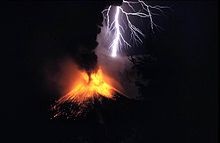 |
| Volcanic material
thrust high into the atmosphere can trigger
lightning. |
Volcanic
Volcanic activity produces lightning-friendly conditions
in multiple ways. The enormous quantity of pulverized
material and gases explosively ejected into the
atmosphere creates a dense plume of particles. The ash
density and constant motion within the volcanic plume
produces charge by frictional interactions (triboelectrification),
resulting in very powerful and very frequent flashes as
the cloud attempts to neutralize itself. Due to the
extensive solid material (ash) content, unlike the water
rich charge generating zones of a normal thundercloud,
it is often called a dirty thunderstorm. |
- Powerful and frequent flashes
have been witnessed in the volcanic plume as far
back as the 79 AD eruption of Vesuvius by Pliny The
Younger.
- Likewise, vapors and ash
originating from vents on the volcano's flanks may
produce more localized and smaller flashes upwards
of 2.9 km long.
- Small, short duration sparks,
recently documented near newly extruded magma,
attest to the material being highly charged prior to
even entering the atmosphere.
|
Fire lightning
Intense forest fires, such as those seen in the 2019–20
Australian bushfire season, can create their own weather
systems that can produce lightning and other weather
phenomena. Intense heat from a fire causes air to
rapidly rise within the smoke plume, causing the
formation of pyrocumulonimbus clouds. Cooler air is
drawn in by this turbulent, rising air, helping to cool
the plume. The rising plume is further cooled by the
lower atmospheric pressure at high altitude, allowing
the moisture in it to condense into cloud.
Pyrocumulonimbus clouds form in an unstable atmosphere.
These weather systems can produce dry lightning, fire
tornadoes, intense winds and dirty hail.
Extraterrestrial
Lightning has been observed within the atmospheres of
other planets, such as Jupiter and Saturn. Although in
the minority on Earth, superbolts appear to be common on
Jupiter.
Lightning on Venus has been a controversial subject
after decades of study. During the Soviet Venera and
U.S. Pioneer missions of the 1970s and 1980s, signals
suggesting lightning may be present in the upper
atmosphere were detected. Although the Cassini–Huygens
mission fly-by of Venus in 1999 detected no signs of
lightning, the observation window lasted mere hours.
Radio pulses recorded by the spacecraft Venus Express
(which began orbiting Venus in April 2006) may originate
from lightning on Venus.
Human-related phenomena |
- Airplane contrails have also
been observed to influence lightning to a small
degree. The water vapor-dense contrails of airplanes
may provide a lower resistance pathway through the
atmosphere having some influence upon the
establishment of an ionic pathway for a lightning
flash to follow.
- Rocket exhaust plumes provided a
pathway for lightning when it was witnessed striking
the Apollo 12 rocket shortly after takeoff.
- Thermonuclear explosions, by
providing extra material for electrical conduction
and a very turbulent localized atmosphere, have been
seen triggering lightning flashes within the
mushroom cloud. In addition, intense gamma radiation
from large nuclear explosions may develop intensely
charged regions in the surrounding air through
Compton scattering. The intensely charged space
charge regions create multiple clear-air lightning
discharges shortly after the device detonates.
|
In culture and religion
In many cultures, lightning has been viewed as part of a
deity or a deity in and of itself. These include the
Greek god Zeus, the Aztec god Tlaloc, the Mayan God K,
Slavic mythology's Perun, the Baltic Pērkons/Perkūnas,
Thor in Norse mythology, Ukko in Finnish mythology, the
Hindu god Indra, and the Shinto god Raijin. In the
traditional religion of the African Bantu tribes,
lightning is a sign of the ire of the gods. Verses in
the Jewish religion and in Islam also ascribe
supernatural importance to lightning. In Christianity,
the Second Coming of Jesus is compared to
lightning.[Matthew 24:27][Luke 17:24]
The expression "Lightning never strikes twice (in the
same place)" is similar to "Opportunity never knocks
twice" in the vein of a "once in a lifetime"
opportunity, i.e., something that is generally
considered improbable. Lightning occurs frequently and
more so in specific areas. Since various factors alter
the probability of strikes at any given location, repeat
lightning strikes have a very low probability (but are
not impossible). Similarly, "A bolt from the blue"
refers to something totally unexpected, and "A person
being struck by lightning" is an imaginative or comedic
metaphor for someone to experience a once in a lifetime,
striking, sudden lightning-speed revelation, similar to
an epiphany or an enlightenment.
Some political parties use lightning flashes as a symbol
of power, such as the People's Action Party in
Singapore, the British Union of Fascists during the
1930s, and the National States' Rights Party in the
United States during the 1950s. The Schutzstaffel, the
paramilitary wing of the Nazi Party, used the Sig rune
in their logo which symbolizes lightning. The German
word Blitzkrieg, which means "lightning war", was a
major offensive strategy of the German army during World
War II.
In French and Italian, the expression for "Love at first
sight" is coup de foudre and colpo di fulmine,
respectively, which literally translated means
"lightning strike". Some European languages have a
separate word for lightning which strikes the ground (as
opposed to lightning in general); often it is a cognate
of the English word "rays". The name of Australia's most
celebrated thoroughbred horse, Phar Lap, derives from
the shared Zhuang and Thai word for lightning.
The bolt of lightning in heraldry is called a
thunderbolt and is shown as a zigzag with non-pointed
ends. This symbol usually represents power and speed.
The lightning bolt is used to represent the
instantaneous communication capabilities of electrically
powered telegraphs and radios. It was a commonly used
motif in Art Deco design, especially the zig-zag Art
Deco design of the late 1920s. The lightning bolt is a
common insignia for military communications units
throughout the world. A lightning bolt is also the NATO
symbol for a signal asset.
The Unicode symbol for lightning is ☇ U+2607. |
|
|
 Kiddle: Lightning Kiddle: Lightning
Wikipedia: Lightning |
|
|
|
|
|
|
|
|
|
|
|
|
|
|
|
|
Search Fun Easy English |
|
|
|
|
|
|
|
|
|
|
|
|
|
|
|
About
Contact
Copyright
Resources
Site Map |